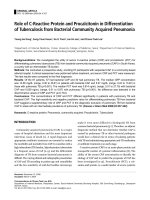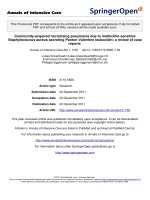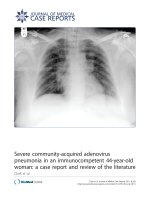community acquired pneumonia
Bạn đang xem bản rút gọn của tài liệu. Xem và tải ngay bản đầy đủ của tài liệu tại đây (803.8 KB, 62 trang )
Community-acquired Pneumonia
Alan D Tice, MD, FACP
Infections Limited
Tacoma, Washington
University of Washington
What is Your Specialty?
1. Primary care
2. Medical specialist
3. Surgery
4. Gynecology
5. Nurse
6. Physician assistant
Primary Patient Care Site
1. Hospital
2. Intensive Care
3. Clinic
4. Skilled nursing facility
5. Home care
How young are you?
1. 30-40 years
2. 40-50
3. 50-60
4. 60-70
5. 70-80
How many cases of pneumonia
have you cared for in the last
year?
1. None
2. 1-5
3. 6-10
4. 11-20
5. More
Community-acquired pneumonia
•
Symptoms consistent with lung infection
•
New pulmonary infiltrate
•
Acquired outside the hospital
Community-Acquired
Pneumonia
•
2-3 million cases/year
•
500,000 hospitalizations/year
•
45,000 deaths/year
–
the most lethal infection
–
14% of those hospitalized die
•
10 million physician visits/year
•
Frequent reason for antibiotic use
Recent Developments in
C. A. P.
•
Antimicrobial resistance
•
New antibiotics
•
New microbiology/technology
•
Managed care
•
Information management
Microbiology of C. A. P.
•
Pathogens
–
Broad range
–
Many still unknown
–
Coinfections
•
Rapid diagnostic testing
•
Susceptibility reporting
–
Alexander project, others
Causative pathogens in 5,961 adults admitted to hospital with CAP
identified in 26 prospective studies from 10 European countries
0 5 10 15 20 25 30
S pneumoniae
S pneumoniae
C pneumoniae
C pneumoniae
Viral
Viral
Mycoplasma
Mycoplasma
pneumoniae
pneumoniae
Legionella sp
Legionella sp
H influenzae
H influenzae
G-neg enterobacteria
G-neg enterobacteria
C psittacii
C psittacii
Coxiella burnetii
Coxiella burnetii
Staph aureus
Staph aureus
M catarrhalis
M catarrhalis
Other
Other
Woodhead M. Chest 1998;183S-187S
Strep. pneumoniae
•
Penicillin
–
Intermediate (MIC-0.1-1.0)
–
Resistant (MIC>2)
•
Ceftriaxone
–
Intermediate (MIC-1)
–
Resistant (MIC-2)
•
Vancomycin
•
80%
•
20%
•
5%
•
95%
•
2%
•
1%
•
100%
Strep. pneumoniae
(% Resistant)
Pen-sensitive Pen-resistant
Penicillin 0 100
Ceftriaxone 0.2 22
New
Quinolones
0.4 1.1
08/12/14 Ho, Pak-Leung AAC,
May, 1999
Hong Kong 1998
Strep. Pneumoniae - 181 strains
•
ANTIBIOTIC
•
Penicillin (MIC>0.06)
•
Ceftriaxone (MIC>0.5)
•
Ciprofloxacin (MIC>2)
•
Levofloxacin (MIC>2)
•
Trovafloxacin (MIC>1)
•
RESISTANCE
•
69.1 %
•
44.2 %
•
12.1 %
•
5.5 %
•
2.2 %
Possible Diagnostic Tests
•
Gram Stain
•
WBC
•
Chest x-ray
•
Pulse oximetry
I routinely use a Gram stain
1. Yes
2. No
I routinely do a CBC
1. Yes
2. No
I often do a Chest x-ray
1. Yes
2. No
I commonly use pulse oximetry
1. Yes
2. No
Rapid Diagnostic studies
•
Gram stain - bacteria
•
Acid fast - mycobacteria
•
DFA - Pneumocystis, influenza, legionella
•
PCR - chlamydia, mycoplasma,
mycobacteria, legionella, hantavirus
•
EIA - influenza, RSV
Antibiotics
•
New antibiotics
–
Cephalosporins
–
Macrolides/ketolides
–
Fluoroquinolones
•
Route of administration
–
Oral
–
Intravenous
–
Intramuscular
•
Pharmacology
–
Once daily
Managed Care
•
Reduce costs
–
Antibiotic
–
Hospitalization
–
Personnel
•
Quality assurance
•
Accountability
•
Clinical pathways
Information Management
•
Large databases
–
Pneumonia Patient Outcomes Research Team
(PORT) study (38,000 patients)
–
Medicare/HCFA
•
Statistical analyses/outcomes
–
Death rate
–
Pathogens
–
Epidemiology
Applications of New Insights
•
Analysis of risk factors
•
Guidelines for evaluation
•
Guidelines for management
•
Antibiotic resistance tracking
Patient Points
characteristics assigned
Demographic factors
Age: males age (in yrs)
females age (in yrs) -10
Nursing home resident +10
Comorbid illnesses
Neoplastic disease +30
Liver disease +20
Congestive heart failure +10
Cerebrovascular disease +10
Renal disease +10
Physical examination findings
Altered mental status +20
Respiratory rate ≥ 30/min +20
Systolic blood pressure
< 90 mmHg +20
Temp. < 35° C or ≥ 40° C +15
Pulse >125 / min +10
Laboratory findings
pH < 7.35 +30
BUN > 10.7 mmol/L +20
Sodium < 130 mEq/L +20
Glucose > 13.9 mmol/L +10
Hematocrit < 30% +10
PO
< 60 mmHg
2
+10
Pleural effusion +10
Prediction model for C A P
Fine MJ, et al. NEJM 1997;336(4)243-250
Risk-Class Mortality Rates for
Patients with Pneumonia
Risk No. of Mortality Recommendations
class No. of points patients (%) for site of care
I No predictors 3,304 0.1 Outpatient
II < 70 5,778 0.6 Outpatient
III 71- 90 6,790 2.8 Inpatient (briefly)
IV 91 - 130 13,104 8.2 Inpatient
V > 130 9,333 29.2 Inpatient
Fine MJ, et al. NEJM 1997;336(4)243-250









